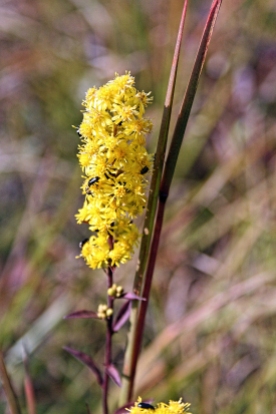Fall is the time of year when goldenrods brighten the fields and roadsides with showy yellow blossoms. It is the time for the last major harvesting of nectar and pollen by bees, wasps, migrating butterflies and many other insects. Nectar gathered by bumblebees and honeybees will help these insects survive the winter. Pollen is also eaten by several species of beetles.
One species of goldenrod is the downy goldenrod. It has bottlebrush-like spikes of yellow flowers and with a magnifier you will see fine hairs on its stems and leaves. Its stems are dark purple-brow.. The downy goldenrod grows in the eastern U. S.
People often have allergies in the fall from a different plant called ragweed. Unlike goldenrods that depend on insects for cross pollination, ragweed depends on the wind to blow pollen from plant to plant. Its pollen is so light that it is carried into the atmosphere where it is breathed in by people, some have severe allergies to it. Often ragweed grows alongside goldenrods, but because goldenrods are showy and ragweed is not, goldenrods get the blame for people’s allergies.
Goldenrods are not the only fall wildflower to provide pollen and nectar for insect. The aster is another another prolific plant in fall landscapes that many insects depend on for their fall harvest.




